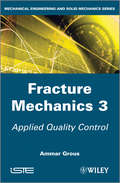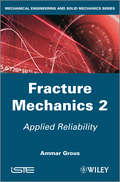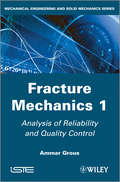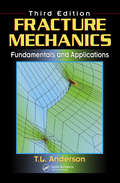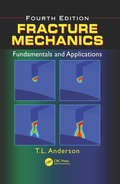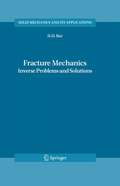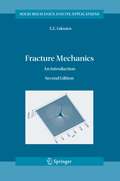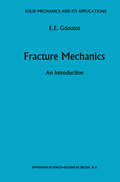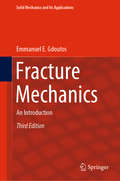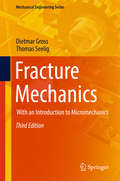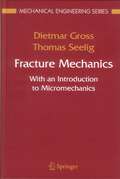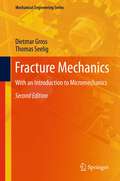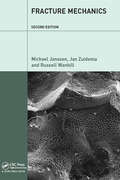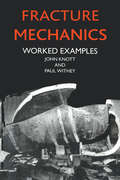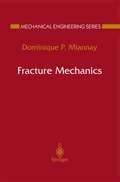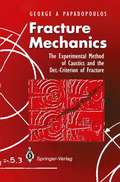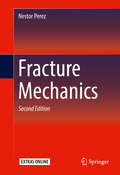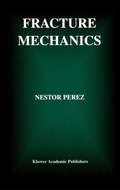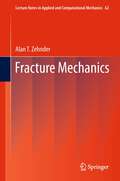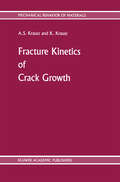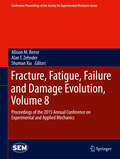- Table View
- List View
Fracture Mechanics 3: Applied Quality Control (Iste Ser. #736)
by Ammar GrousThis third book of a 3-volume set on Fracture Mechanics adds a pragmatic and supportive character to the previous volumes by focusing on case studies using corrected exercises that teachers, students or engineers will find extremely useful. Due to the wide themes approached in this series, it can also be used to organize work in this field in a new way, as well as in the maintenance of industrial plants.Several cases of sampling plans and their applications in industry are presented, as well as several solved case studies on the main indicators of capability according to ISO/TS 16949, ISO 8258 and FORD.This book distinguishes itself from other works in the field through its originality in presenting an educational approach which aims at helping practitioners both in academia and industry. It is intended for technicians, engineers, designers, students, and teachers working in the fields of engineering and vocational education. The main objective of the author is to provide an assessment of indicators of quality and reliability to aid in decision-making. To this end, an intuitive and practical approach, based on mathematical rigor, is recommended.
Fracture Mechanics 3: Applied Quality Control
by Ammar GrousThis third book of a 3-volume set on Fracture Mechanics adds a pragmatic and supportive character to the previous volumes by focusing on case studies using corrected exercises that teachers, students or engineers will find extremely useful. Due to the wide themes approached in this series, it can also be used to organize work in this field in a new way, as well as in the maintenance of industrial plants.Several cases of sampling plans and their applications in industry are presented, as well as several solved case studies on the main indicators of capability according to ISO/TS 16949, ISO 8258 and FORD.This book distinguishes itself from other works in the field through its originality in presenting an educational approach which aims at helping practitioners both in academia and industry. It is intended for technicians, engineers, designers, students, and teachers working in the fields of engineering and vocational education. The main objective of the author is to provide an assessment of indicators of quality and reliability to aid in decision-making. To this end, an intuitive and practical approach, based on mathematical rigor, is recommended.
Fracture Mechanics 2: Applied Reliability (Iste Ser. #737)
by Ammar GrousThis second book of a 3-volume set on Fracture Mechanics completes the first volume through the analysis of adjustment tests suited to correctly validating the justified use of the laws conforming to the behavior of the materials and structures under study.This volume focuses on the vast range of statistical distributions encountered in reliability. Its aim is to run statistical measurements, to present a report on enhanced measures in mechanical reliability and to evaluate the reliability of repairable or unrepairable systems. To achieve this, the author presents a theoretical and practice-based approach on the following themes: criteria of failures; Bayesian applied probability; Markov chains; Monte Carlo simulation as well as many other solved case studies.This book distinguishes itself from other works in the field through its originality in presenting an educational approach which aims at helping practitioners both in academia and industry. It is intended for technicians, engineers, designers, students, and teachers working in the fields of engineering and vocational education. The main objective of the author is to provide an assessment of indicators of quality and reliability to aid in decision-making. To this end, an intuitive and practical approach, based on mathematical rigor, is recommended.
Fracture Mechanics 2: Applied Reliability
by Ammar GrousThis second book of a 3-volume set on Fracture Mechanics completes the first volume through the analysis of adjustment tests suited to correctly validating the justified use of the laws conforming to the behavior of the materials and structures under study.This volume focuses on the vast range of statistical distributions encountered in reliability. Its aim is to run statistical measurements, to present a report on enhanced measures in mechanical reliability and to evaluate the reliability of repairable or unrepairable systems. To achieve this, the author presents a theoretical and practice-based approach on the following themes: criteria of failures; Bayesian applied probability; Markov chains; Monte Carlo simulation as well as many other solved case studies.This book distinguishes itself from other works in the field through its originality in presenting an educational approach which aims at helping practitioners both in academia and industry. It is intended for technicians, engineers, designers, students, and teachers working in the fields of engineering and vocational education. The main objective of the author is to provide an assessment of indicators of quality and reliability to aid in decision-making. To this end, an intuitive and practical approach, based on mathematical rigor, is recommended.
Fracture Mechanics 1: Analysis of Reliability and Quality Control
by Ammar GrousThis first book of a 3-volume set on Fracture Mechanics is mainly centered on the vast range of the laws of statistical distributions encountered in various scientific and technical fields. These laws are indispensable in understanding the probability behavior of components and mechanical structures that are exploited in the other volumes of this series, which are dedicated to reliability and quality control.The author presents not only the laws of distribution of various models but also the tests of adequacy suited to confirm or counter the hypothesis of the law in question, namely the Pearson (x2) test, the Kolmogorov-Smirnov (KS) test, along with many other relevant tests.This book distinguishes itself from other works in the field through its originality in presenting an educational approach which aims at helping practitioners both in academia and industry. It is intended for technicians, engineers, designers, students, and teachers working in the fields of engineering and vocational education. The main objective of the author is to provide an assessment of indicators of quality and reliability to aid in decision-making. To this end, an intuitive and practical approach, based on mathematical rigor, is recommended.
Fracture Mechanics 1: Analysis of Reliability and Quality Control
by Ammar GrousThis first book of a 3-volume set on Fracture Mechanics is mainly centered on the vast range of the laws of statistical distributions encountered in various scientific and technical fields. These laws are indispensable in understanding the probability behavior of components and mechanical structures that are exploited in the other volumes of this series, which are dedicated to reliability and quality control.The author presents not only the laws of distribution of various models but also the tests of adequacy suited to confirm or counter the hypothesis of the law in question, namely the Pearson (x2) test, the Kolmogorov-Smirnov (KS) test, along with many other relevant tests.This book distinguishes itself from other works in the field through its originality in presenting an educational approach which aims at helping practitioners both in academia and industry. It is intended for technicians, engineers, designers, students, and teachers working in the fields of engineering and vocational education. The main objective of the author is to provide an assessment of indicators of quality and reliability to aid in decision-making. To this end, an intuitive and practical approach, based on mathematical rigor, is recommended.
Fracture Mechanics: Fundamentals and Applications, Third Edition
by T. L. AndersonWith its combination of practicality, readability, and rigor that is characteristic of any truly authoritative reference and text, Fracture Mechanics: Fundamentals and Applications quickly established itself as the most comprehensive guide to fracture mechanics available. It has been adopted by more than 100 universities and embraced by thousands o
Fracture Mechanics: Fundamentals and Applications, Fourth Edition
by Ted L. AndersonFracture Mechanics: Fundamentals and Applications, Fourth Edition is the most useful and comprehensive guide to fracture mechanics available. It has been adopted by more than 150 universities worldwide and used by thousands of engineers and researchers. This new edition reflects the latest research, industry practices, applications, and computational analysis and modeling. It encompasses theory and applications, linear and nonlinear fracture mechanics, solid mechanics, and materials science with a unified, balanced, and in-depth approach. Numerous chapter problems have been added or revised, and additional resources are available for those teaching college courses or training sessions. Dr. Anderson’s own website can be accessed at www.FractureMechanics.com.
Fracture Mechanics: Inverse Problems and Solutions (Solid Mechanics and Its Applications #139)
by Huy Duong BuiThis book presents, in a unified manner, a variety of topics in Continuum and Fracture Mechanics: energy methods, conservation laws, mathematical methods to solve two-dimensional and three-dimensional crack problems. Moreover, a series of new subjects is presented in a straightforward manner, accessible to under-graduate students. Emphasizing physical or experimental back-grounds, then analysis and theoretical results, this monograph is intended for use by students and researchers in solid mechanics, mechanical engineering and applied mathematics.
Fracture Mechanics: An Introduction (Solid Mechanics and Its Applications #123)
by E.E. GdoutosNew developments in the applications of fracture mechanics to engineering problems have taken place in the last years. Composite materials have extensively been used in engineering problems. Quasi-brittle materials including concrete, cement pastes, rock, soil, etc. all benefit from these developments. Layered materials and especially thin film/substrate systems are becoming important in small volume systems used in micro and nanoelectromechancial systems (MEMS and NEMS). Nanostructured materials are being introduced in our every day life. In all these problems fracture mechanics plays a major role for the prediction of failure and safe design of materials and structures. These new challenges motivated the author to proceed with the second edition of the book. The second edition of the book contains four new chapters in addition to the ten chapters of the first edition. The fourteen chapters of the book cover the basic principles and traditional applications, as well as the latest developments of fracture mechanics as applied to problems of composite materials, thin films, nanoindentation and cementitious materials. Thus the book provides an introductory coverage of the traditional and contemporary applications of fracture mechanics in problems of utmost technological importance. With the addition of the four new chapters the book presents a comprehensive treatment of fracture mechanics. It includes the basic principles and traditional applications as well as the new frontiers of research of fracture mechanics during the last three decades in topics of contemporary importance, like composites, thin films, nanoindentation and cementitious materials. The book contains fifty example problems and more than two hundred unsolved problems. A "Solutions Manual" is available upon request for course instructors from the author.
Fracture Mechanics: An Introduction (Solid Mechanics and Its Applications #14)
by E.E. GdoutosNew developments in the applications of fracture mechanics to engineering problems have taken place in the last years. Composite materials have extensively been used in engineering problems. Quasi-brittle materials including concrete, cement pastes, rock, soil, etc. all benefit from these developments. Layered materials and especially thin film/substrate systems are becoming important in small volume systems used in micro and nanoelectromechancial systems (MEMS and NEMS). Nanostructured materials are being introduced in our every day life. In all these problems fracture mechanics plays a major role for the prediction of failure and safe design of materials and structures. These new challenges motivated the author to proceed with the second edition of the book. The second edition of the book contains four new chapters in addition to the ten chapters of the first edition. The fourteen chapters of the book cover the basic principles and traditional applications, as well as the latest developments of fracture mechanics as applied to problems of composite materials, thin films, nanoindentation and cementitious materials. Thus the book provides an introductory coverage of the traditional and contemporary applications of fracture mechanics in problems of utmost technological importance. With the addition of the four new chapters the book presents a comprehensive treatment of fracture mechanics. It includes the basic principles and traditional applications as well as the new frontiers of research of fracture mechanics during the last three decades in topics of contemporary importance, like composites, thin films, nanoindentation and cementitious materials. The book contains fifty example problems and more than two hundred unsolved problems. A "Solutions Manual" is available upon request for course instructors from the author.
Fracture Mechanics: An Introduction (Solid Mechanics and Its Applications #263)
by Emmanuel E. GdoutosThis book discusses the basic principles and traditional applications of fracture mechanics, as well as the cutting-edge research in the field over the last three decades in current topics like composites, thin films, nanoindentation, and cementitious materials.Experimental methods play a major role in the study of fracture mechanics problems and are used for the determination of the major fracture mechanics quantities such as stress intensity factors, crack tip opening displacements, strain energy release rates, crack paths, crack velocities in static and dynamic problems. These methods include electrical resistance strain gauges, photoelasticity, interferometry techniques, geometric and interferometry moiré, and the optical method of caustics.Furthermore, numerical methods are often used for the determination of fracture mechanics parameters. They include finite and boundary element methods, Green’s function and weight functions, boundary collocation, alternating methods, and integral transforms continuous dislocations.This third edition of the book covers the basic principles and traditional applications, as well as the latest developments of fracture mechanics. Featuring two new chapters and 30 more example problems, it presents a comprehensive overview of fracture mechanics, and includes numerous examples and unsolved problems. This book is suitable for teaching fracture mechanics courses at the undergraduate and graduate levels. A “solutions manual” is available for course instructors upon request.
Fracture Mechanics: With an Introduction to Micromechanics (Mechanical Engineering Series)
by Dietmar Gross Thomas Seelig- self-contained and well illustrated- complete and comprehensive derivation of mechanical/mathematical results with enphasis on issues of practical importance- combines classical subjects of fracture mechanics with modern topics such as microheterogeneous materials, piezoelectric materials, thin films, damage- mechanically and mathematically clear and complete derivations of results
Fracture Mechanics: With an Introduction to Micromechanics (Mechanical Engineering Series)
by Dietmar Gross Thomas Seelig- self-contained and well illustrated - complete and comprehensive derivation of mechanical/mathematical results with enphasis on issues of practical importance - combines classical subjects of fracture mechanics with modern topics such as microheterogeneous materials, piezoelectric materials, thin films, damage - mechanically and mathematically clear and complete derivations of results
Fracture Mechanics: With an Introduction to Micromechanics (Mechanical Engineering Series)
by Dietmar Gross Thomas Seelig- self-contained and well illustrated- complete and comprehensive derivation of mechanical/mathematical results with enphasis on issues of practical importance- combines classical subjects of fracture mechanics with modern topics such as microheterogeneous materials, piezoelectric materials, thin films, damage- mechanically and mathematically clear and complete derivations of results
Fracture Mechanics: Fundamentals and Applications
by Michael Janssen Jan Zuidema Russell WanhillSince the first edition published in 1991, this has been one of the top-selling books in the field. The first and second editions have been used as a required text in over 100 universities worldwide and have become indispensable reference for thousands of practising engineers as well. The third edition reflects recent advances in the field, althoug
Fracture Mechanics: Worked Examples
by John Knott Paul WitneyThis book is aimed at those in both industry and academic institutions who require a grounding not only in the basic principles of this important field but also in the practical aspects of evaluating fracture mechanics parameters.
Fracture Mechanics: Worked Examples
by John Knott Paul WitneyThis book is aimed at those in both industry and academic institutions who require a grounding not only in the basic principles of this important field but also in the practical aspects of evaluating fracture mechanics parameters.
Fracture Mechanics (Mechanical Engineering Series)
by Dominique P. MiannayIntended for engineers from a variety of disciplines dealing with structural materials, this text describes the current state of knowledge. It begins by describing the fracture process at the two extremes of scale: first in the context of atomic structures, then in terms of a continuous elastic medium. Treating the fracture process in increasingly sophisticated ways, the book then considers plastic corrections and the procedures for measuring the toughness of materials. Practical considerations are then discussed, including crack propagation, geometry dependence, flaw density, mechanisms of failure by cleavage, the ductile-brittle transition, and continuum damage mechanics. The whole is rounded off with discussions of generalised plasticity and the link between the microscopic and macroscopic aspects, and problems are provided at the end of each chapter.
Fracture Mechanics: The Experimental Method of Caustics and the Det.-Criterion of Fracture
by George A. PapadopoulosFracture and Mechanics is concerned with the experimental method of static and dynamic caustics and the Distribution of Determinant (Det.)-criterion of fracture. The Det.-criterion determines the conditions causing a crack and gives information on the expected angle of crack propagation. The object of this publication is to present the latest results to the re.earch and development community and to assist the teaching of experimental fracture mechanics and stress analysis in undergraduate and postgraduate courses. After discussing the basic theoretical considerations on the subject, experimental techniques and applications are introduced. Most of the results presented are based on the author's own investigations in the field of experimental mechanics since 1973 at the National Technical University of Athens.
Fracture Mechanics (Mathematics And Its Applications Ser.)
by Nestor PerezThe second edition of this textbook includes a refined presentation of concepts in each chapter, additional examples; new problems and sections, such as conformal mapping and mechanical behavior of wood; while retaining all the features of the original book. The material included in this book is based upon the development of analytical and numerical procedures pertinent to particular fields of linear elastic fracture mechanics (LEFM) and plastic fracture mechanics (PFM), including mixed-mode-loading interaction. The mathematical approach undertaken herein is coupled with a brief review of several fracture theories available in cited references, along with many color images and figures. Dynamic fracture mechanics is included through the field of fatigue and Charpy impact testing.
Fracture Mechanics (Mathematics And Its Applications Ser.)
by Nestor PerezFracture Mechanics is a graduate level text/professional reference that describes the analytical methods used to derive stress and strain functions related to fracture mechanics. The focus of the book will be on modeling and problem solving as tools to be used in interpreting the meaning of a mathematical solution for a particular engineering problem or situation. Once this is accomplished, the reader should be able to think mathematically, foresee metallurgically the significance of microstructural parameters on properties, analyze the mechanical behavior of materials, and recognize realistically how dangerous a crack is in a stressed structure, which may fail catastrophically. This book differs from others in that the subject matter is organized around the modeling and predicating approaches that are used to explain the detrimental effects of crack growth events. Thus, this book will take a more practical approach and make it especially useful as a basic reference for professional engineers.
Fracture Mechanics (Lecture Notes in Applied and Computational Mechanics #62)
by Alan T. ZehnderFracture mechanics is a vast and growing field. This book develops the basic elements needed for both fracture research and engineering practice. The emphasis is on continuum mechanics models for energy flows and crack-tip stress- and deformation fields in elastic and elastic-plastic materials. In addition to a brief discussion of computational fracture methods, the text includes practical sections on fracture criteria, fracture toughness testing, and methods for measuring stress intensity factors and energy release rates. Class-tested at Cornell, this book is designed for students, researchers and practitioners interested in understanding and contributing to a diverse and vital field of knowledge.
Fracture Kinetics of Crack Growth (Mechanical Behavior of Materials #1)
by A.S. KrauszOver the past few years, we have made numerous presentations, delivered several series of lectures, and participated in many discussions on the processes of time-dependent crack growth. We felt that the understanding of these processes had reached a degree of maturity: the basic physical principles were established and their application to engineering practice was now feasible. We concluded that the best way to organize this knowledge was to write it up in a single, coherent system. Martinus Nijhoff kindly encouraged us and generously offered their collaboration. Hence, this book. The physical process of time-dependent subcritical crack growth is rigorously defined by statistical mechanics. If well presented, the principles can be readily understood by practitioners of fracture research and design engineers. We present the physical processes of crack growth in terms of atomic interactions that assume only a working knowledge of the standard engineering materials course contents. From this, we develop a framework that is valid for any type of material, be it metallic, polymeric, ceramic, glass or mineral - indeed, any solid. We also assume an elementary exposure to fracture mechanics. An appendix is provided that outlines those aspects of fracture mechanics that are needed for an introduction to fracture kinetics analyses; it also provides a common ground for concepts and terminology (see Appendix A). We proceed through theory to applications that are of interest in research, development and design, as well as in test and operating engineering practice.
Fracture, Fatigue, Failure and Damage Evolution, Volume 8: Proceedings of the 2015 Annual Conference on Experimental and Applied Mechanics (Conference Proceedings of the Society for Experimental Mechanics Series)
by Allison M. Beese Alan T. Zehnder Shuman XiaFracture, Fatigue, Failure and Damage Evolution, Volume 8 represents the eighth of nine volumes of technical papers presented at the Society for Experimental Mechanics (SEM) 15th International Congress & Exposition on Experimental and Applied Mechanics, held at Costa Mesa, California, June 8-11, 2015. The full set of proceedings also includes volumes on: Dynamic Behavior of Materials, Challenges in Mechanics of Time Dependent Materials, Advancement of Optical Methods in Experimental Mechanics, Experimental and Applied Mechanics, 16th International Symposium on MEMS and Nanotechnology, International Symposium on the Mechanics of Composite and Multi-functional Materials, 5th International Symposium on the Mechanics of Biological Systems and Materials, International Symposium on the Mechanics of Composite and Multi-functional Materials; and Residual Stress, Thermomechanics & Infrared Imaging, Hybrid Techniques and Inverse Problems.
